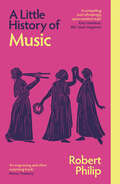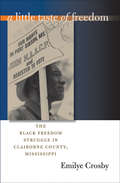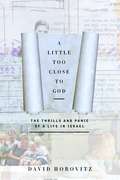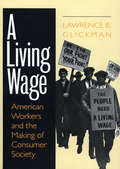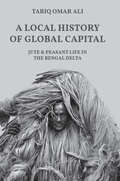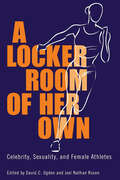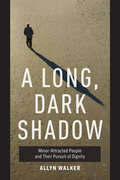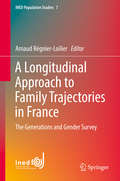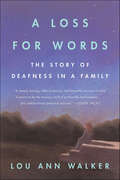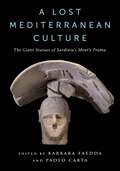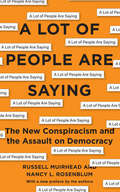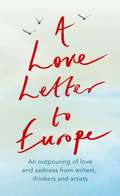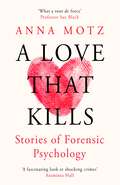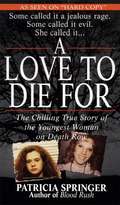- Table View
- List View
A Little History Of The English Country Church
by Roy StrongBeautifully illustrated narrative history of the English country church In his engaging account, Sir Roy Strong celebrates the life of the English parish churchFrom the arrival of the missionaries from Ireland and Rome, to the beautiful architecture and rich spirituality of medieval Catholicism; from the cataclysm of the Reformation, to the gentrified cleric we meet in Jane Austen novels, Roy Strong takes us on a journey - historical, social and spiritual - to explore what men and women experienced through the age when they went to church on Sunday.‘Anyone with the slightest interest in the English parish church, of its life today, or its history will be intrigued, informed and enchanted by this lucid, and occasionally provocative, account’ Country Life
A Little History of Music (Little Histories)
by Robert PhilipA lively, engaging guide to music around the world, from prehistory to the present Human beings have always made music. Music can move us and tell stories of faith, struggle, or love. It is common to all cultures across the world. But how has it changed over the millennia? Robert Philip explores the extraordinary history of music in all its forms, from our earliest ancestors to today&’s mass-produced songs. This is a truly global story. Looking to Europe, South America, Asia, Africa, and beyond, Philip reveals how musicians have been brought together by trade and migration and examines the vast impact of colonialism. From Hildegard von Bingen and Clara Schumann to Bob Dylan and Aretha Franklin, great performers and composers have profoundly shaped music as we know it. Covering a remarkable range of genres, including medieval chant, classical opera, jazz, and hip hop, this Little History shines a light on the wonder of music—and why it is treasured across the world.
A Little History of Psychology (Little Histories)
by Nicky HayesA rich and engaging guide to psychology, the science devoted to understanding human nature What really drives our decisions? Where do language and memory come from? Why do our minds sometimes seem to work against us? Psychologists have long attempted to answer these questions, seeking to understand human behaviour, feelings, and thoughts. But how to explore something so elusive? In this fascinating history, leading expert Nicky Hayes tells the story of psychology across the centuries and around the world. Hayes introduces key thinkers, including Carl Jung, Anna Freud, Frantz Fanon, and Daniel Kahneman. We see how they tried to expand our understanding, from Pavlov and his dogs to Milgram and his famous electric shock experiments to the CIA’s secret mind-control projects. Hayes explores key concepts like child development, the inferiority complex, and PTSD and shows how psychological research has been used for both good and ill. This Little History shines a light on the ever-advancing study of psychology, how the field has evolved over time—and how much more we need to learn.
A Little History of the United States
by James West DavidsonHow did a land and people of such immense diversity come together under a banner of freedom and equality to form one of the most remarkable nations in the world? Everyone from young adults to grandparents will be fascinated by the answers uncovered in James West Davidson's vividly told A Little History of the United States. In 300 fast-moving pages, Davidson guides his readers through 500 years, from the first contact between the two halves of the world to the rise of America as a superpower in an era of atomic perils and diminishing resources. In short, vivid chapters the book brings to life hundreds of individuals whose stories are part of the larger American story. Pilgrim William Bradford stumbles into an Indian deer trap on his first day in America; Harriet Tubman lets loose a pair of chickens to divert attention from escaping slaves; the toddler Andrew Carnegie, later an ambitious industrial magnate, gobbles his oatmeal with a spoon in each hand. Such stories are riveting in themselves, but they also spark larger questions to ponder about freedom, equality, and unity in the context of a nation that is, and always has been, remarkably divided and diverse.
A Little Piece of Light: A Memoir of Hope, Prison, and a Life Unbound
by Kristine Gasbarre Donna HyltonA memoir of survival, redemption, hope, and sisterhood from a bold new voice on the front lines of the criminal justice reform movement. Like so many women before her and so many women yet to come, Donna Hylton's early life was a nightmare of abuse that left her feeling alone and convinced of her worthlessness. In 1986, she took part in a horrific act and was sentenced to 25 years to life for kidnapping and second-degree murder. It seemed that Donna had reached the end--at age 19, due to her own mistakes and bad choices, her life was over. A Little Piece of Light tells the heartfelt, often harrowing tale of Donna's journey back to life as she faced the truth about the crime that locked her away for 27 years...and celebrated the family she found inside prison that ultimately saved her. Behind the bars of Bedford Hills Correctional Facility, alongside this generation's most infamous criminals, Donna learned to fight, then thrive. For the first time in her life, she realized she was not alone in the abuse and misogyny she experienced--and she was also not alone in fighting back. Since her release in 2012, Donna has emerged as a leading advocate for criminal justice reform and women's rights who speaks to politicians, violent abusers, prison officials, victims, and students to tell her story. But it's not her story alone, she is quick to say. She also represents the stories of thousands of women who have been unable to speak for themselves, until now.
A Little Rebellion
by Bridget MoranIn 1964, social worker Bridget Moran attracted widespread attention and the wrath of the BC government with her open letter to Premier W.A.C. Bennett, charging the welfare department with gross neglect in addressing the problems of the province's needy. This very public dispute formed a small part of Bridget Moran's "little rebellion" against a system she felt did not, and does not, respond to the needs of those it was designed to help. A Little Rebellion is a moving portrait of a fiery and outspoken woman whose ongoing activism is inspired by a deeply-felt desire for social and political justice.Now in its 4th printing.
A Little Taste of Freedom
by Emilye CrosbyIn this long-term community study of the freedom movement in rural, majority-black Claiborne County, Mississippi, Emilye Crosby explores the impact of the African American freedom struggle on small communities in general and questions common assumptions that are based on the national movement. The legal successes at the national level in the mid 1960s did not end the movement, Crosby contends, but rather emboldened people across the South to initiate waves of new actions around local issues. Escalating assertiveness and demands of African Americans--including the reality of armed self-defense--were critical to ensuring meaningful local change to a remarkably resilient system of white supremacy. In Claiborne County, a highly effective boycott eventually led the Supreme Court to affirm the legality of economic boycotts for political protest. NAACP leader Charles Evers (brother of Medgar) managed to earn seemingly contradictory support from the national NAACP, the segregationist Sovereignty Commission, and white liberals. Studying both black activists and the white opposition, Crosby employs traditional sources and more than 100 oral histories to analyze the political and economic issues in the postmovement period, the impact of the movement and the resilience of white supremacy, and the ways these issues are closely connected to competing histories of the community.
A Little Too Close To God: The Thrills and Panic of a Life in Israel
by David HorovitzJournalist David Horovitz describes his life in Israel since his emigration from England in 1983. Throughout the text, he struggles with the conflict between the dangers and benefits of raising his family in Israel. He describes the effects of Rabin's assassination, the incursions of the ultra-Orthodox into daily life, the anxieties of parents as their children approach the age of mandatory military service, and the constant fear of violent attack by fundamentalist extremists. Annotation c. Book News, Inc. , Portland, OR (booknews. com)
A Living Wage: American Workers and the Making of Consumer Society
by Lawrence B. GlickmanThe fight for a "living wage" has a long and revealing history as documented here by Lawrence B. Glickman. The labor movement's response to wages shows how American workers negotiated the transition from artisan to consumer, opening up new political possibilities for organized workers and creating contradictions that continue to haunt the labor movement today. Nineteenth-century workers hoped to become self-employed artisans, rather than permanent "wage slaves." After the Civil War, however, unions redefined working-class identity in consumerist terms, and demanded a wage that would reward workers commensurate with their needs as consumers. This consumerist turn in labor ideology also led workers to struggle for shorter hours and union labels. First articulated in the 1870s, the demand for a living wage was voiced increasingly by labor leaders and reformers at the turn of the century. Glickman explores the racial, ethnic, and gender implications, as white male workers defined themselves in contrast to African Americans, women, Asians, and recent European immigrants. He shows how a historical perspective on the concept of a living wage can inform our understanding of current controversies.
A Living: Working-Class Americans Talk to Their Doctor
by Michael D. SteinFrom a leading public health expert and physician, and in the style of Studs Terkel's Working, comes an eye-opening look at what it&’s like to have to work physically hard for your money in America . . .A Living is a vivid portrait of the working lives of the patients who visit Dr. Michael Stein, a primary care doctor in urban America. What makes his patients unique is that they, by and large, do demanding manual labor. Very few have the luxury of working remotely, or seated. Inspired by Studs Terkel&’s classic Working, Stein produces an eye-opening look at what it&’s like to have to work long hours at physical jobs for a paycheck in America. A Living is composed of vignettes, snap shots of people&’s working lives, the dramas, disappointments and frustrations workers have with their colleagues, family co-workers, and supervisors.And yet it also captures the sense of accomplishment and satisfaction, the opportunities for initiative and self-expression that come from doing intricate work with one&’s hands. Work gives Stein&’s patients a sense of identity and a social environment to thrive in.Ultimately, A Living is an extraordinarily powerful and poetic tableaux of working-class America at this moment when manual labor may be the final refuge in the new era of AI.
A Local History of Global Capital: Jute and Peasant Life in the Bengal Delta (Histories of Economic Life)
by Tariq AliBefore the advent of synthetic fibers and cargo containers, jute sacks were the preferred packaging material of global trade, transporting the world's grain, cotton, sugar, tobacco, coffee, wool, guano, and bacon. Jute was the second-most widely consumed fiber in the world, after cotton. While the sack circulated globally, the plant was cultivated almost exclusively by peasant smallholders in a small corner of the world: the Bengal delta. This book examines how jute fibers entangled the delta's peasantry in the rhythms and vicissitudes of global capital.Taking readers from the nineteenth-century high noon of the British Raj to the early years of post-partition Pakistan in the mid-twentieth century, Tariq Omar Ali traces how the global connections wrought by jute transformed every facet of peasant life: practices of work, leisure, domesticity, and sociality; ideas and discourses of justice, ethics, piety, and religiosity; and political commitments and actions. Ali examines how peasant life was structured and restructured with oscillations in global commodity markets, as the nineteenth-century period of peasant consumerism and prosperity gave way to debt and poverty in the twentieth century.A Local History of Global Capital traces how jute bound the Bengal delta's peasantry to turbulent global capital, and how global commodity markets shaped everyday peasant life and determined the difference between prosperity and poverty, survival and starvation.
A Locker Room of Her Own: Celebrity, Sexuality, and Female Athletes
by Jack LuleFemale athletes are too often perceived as interlopers in the historically male-dominated world of sports. Obstacles specific to women are of particular focus in A Locker Room of Her Own. Race, sexual orientation, and the similar qualities ancillary to gender bear special exploration in how they impact an athlete's story. Central to this volume is the contention that women in their role as inherent outsiders are placed in a unique position even more complicated than the usual experiences of inequality and discord associated with race and sports. The contributors explore and critique the notion that in order to be considered among the pantheon of athletic heroes one cannot deviate from the traditional demographic profile, that of the white male. These essays look specifically and critically at the nature of gender and sexuality within the contested nexus of race, reputation, and sport. The collection explores the reputations of iconic and pioneering sports figures and the cultural and social forces that helped to forge their unique and often problematic legacies. Women athletes discussed in this volume include Babe Didrikson Zaharias, the women of the AAGPBL, Billie Jean King, Venus and Serena Williams, Marion Jones, Chris Evert and Martina Navratilova, Sheryl Swoopes, Florence Griffith Joyner, Roberta Gibb and Kathrine Switzer, and Danica Patrick.
A Long Bright Future
by Laura CarstensenThe twentieth century bequeathed us a fabulous gift: thirty more years of life on average. Supersized life spans are going to radically alter society, and present an unprecedented opportunity to change our approach not only to old age but to all of life’s stages. The ramifications are just beginning to dawn on us. . . . yet in the meantime, we keep thinking about, and planning for, life as it used to be lived. In A Long Bright Future, longevity and aging expert Laura Carstensen guides us into the new possibilities offered by a longer life. She debunks the myths and misconceptions about aging that stop us from adequately preparing for the future both as individuals and as a society: that growing older is associated with loneliness and unhappiness, and that only the genetically blessed live well and long. She then focuses on other important components of a long life, including finances, health, social relationships, Medicare and Social Security, challenging our preconceived notions of "old age” every step of the way.
A Long Journey Home: Losing and Remaking Home following Conflict and Displacement (Forced Migration)
by Luis Eduardo MurciaAdvancing contemporary scholarly debates on the role of home in understanding displacement and emplacement, A Long Journey Home explores powerful personal narratives from Colombia. The book examines the experiences of those whose sense of home has been disrupted by decades of conflict and violence. It highlights the profound feelings of loss and the enduring struggle of living without a home – an experience that can last for years or even decades. Through these stories, the book reveals how internally displaced people use creativity and imagination to remake their home while on the move.
A Long Time Burning: The History of Literary Censorship in England (Routledge Revivals)
by Donald ThomasCensorship of the written word has proved a constant source for debate and argument. To cut or not to cut is a question with a long and fascinating history. First published in 1969, A Long Time Burning is an account of the political, religious, and moral censorship of literature, in the context of English literary history. It is principally concerned with the evolution of a modern pattern of censorship between the abolition of licensing in 1695 and the late Victorian period. The author outlines the motives and methods of censorship, illustrating these by more detailed discussion of such cases as those involving Edmund Curll, John Wilkes, Thomas Paine, William Hone, Richard Carlile, William Dugdale and Henry Vizetelly. The unofficial trade in banned books and the campaigns of the Proclamation Society; the Society for the Suppression of Vice, and the National Vigilance Association are described with the aid of some previously unpublished material.The book includes an anthology of illustrative material, quoting extracts from publications banned at various times and for various reasons. Pages from such books as Venus in the Cloister are reprinted for the first time in more than two centuries, while the other documents range from the Blasphemy Act of 1698 to a prosecution brought under the Race Relations Act of 1965.
A Long, Dark Shadow: Minor-Attracted People and Their Pursuit of Dignity
by Allyn WalkerChallenging widespread assumptions that persons who are preferentially attracted to minors—often referred to as "pedophiles"—are necessarily also predators and sex offenders, this book takes readers into the lives of non-offending minor-attracted persons (MAPs). There is little research into non-offending MAPs, a group whose experiences offer valuable insights into the prevention of child abuse. Navigating guilt, shame, and fear, this universally maligned group demonstrates remarkable resilience and commitment to living without offending and to supporting and educating others. Using data from interview-based research, A Long, Dark Shadow offers a crucial account of the lived experiences of this hidden population.
A Longhouse Fragmented: Ohio Iroquois Autonomy in the Nineteenth Century
by Brian Joseph GilleyA Longhouse Fragmented is a historic ethnography of the Ohio Iroquois and, in particular, of the people known as the Seneca of Sandusky during the early nineteenth century. Using contemporary social theory and interdisciplinary methodologies, Brian Joseph Gilley tells the social history of the Native peoples of Ohio before and during the sociopolitical buildup to removal. As culturally, geographically, and socially displaced Iroquois, the Sandusky Iroquois were fragmented away from American historiographical constructions of Iroquois social history by the American Indian academic establishment. This fragmentation makes the early cultural history of the Ohio Iroquois an ideal foil through which to consider how normalized interpretations of social history come to appear real and have real effects for the subject societies well into the twentieth century. These stories are intended to begin an overdue conversation about the effects of a unified Iroquois history congealed around highly specific categories of knowledge.
A Longitudinal Approach to Family Trajectories in France
by Arnaud Régnier-LoilierAdopting a longitudinal approach, this book examines the dynamics of union and family formation in France and its effects on various aspects of life, such as employment, intergenerational transfers, etc. Drawing on data from a survey in which the same respondents were interviewed three times at three-year intervals, the book explores how demographic behaviours are influenced across the life course at individual level and assesses some of their consequences. The contributors give a clear understanding of how family behaviours are constructed and redefined. They track changes in respondents’ lives in order to pinpoint the factors that prevent couples from realizing their fertility intentions, for example, or to identify certain determinants of union formation or dissolution. They also provide a more detailed picture of the changes that shape family behaviours, such as the impact of a birth on the working career or on intergenerational support, and much more. Using longitudinal data from the French version of the Generations and Gender Survey (GGS), this book addresses family and childbearing behaviours dynamically, as processes that interact with each other and with the other components of each individual's life course.
A Loss for Words: The Story of Deafness in a Family
by Lou Ann Walker“A personal journey of introspection by a young woman whose childhood was spent as parent to her deaf parents” (Kirkus Reviews).From the time she was a toddler, Lou Ann Walker acted as the ears and voice for her parents, who lost their hearing at a young age. As soon as she was old enough to speak, she assumed the responsibility of interpreter—confirming doctors’ appointments and managing her parents’ business transactions. While the Walkers’ family was warm and loving, outside the comfort of their home, they faced a world that misunderstood and often rejected them.In this deeply moving memoir, Walker offers us a glimpse of a different world, bringing with it a broader reflection on how parents grow alongside their children and how children learn to navigate the world through the eyes of their parents. In recounting her story, she encourages us to question the inequalities that shape our society, introduces us to the warm, supportive deaf community, and illuminates the creativity and kindness of humanity.Winner of the Christopher Award“A deeply moving, often humorous, and beautiful account of what it means to be the hearing child of profoundly deaf parents . . . I have rarely read anything on the subject more powerful or poignant than this extraordinary personal account by Lou Ann Walker.” — Oliver Sacks
A Lost Mediterranean Culture: The Giant Statues of Sardinia's Mont'e Prama (Columbiana)
by Faedda, Barbara; Carta, PaoloThousands of shattered limestone pieces came to light in 1974 at the Mont’e Prama site in western Sardinia. They have been reassembled into dozens of striking, colossal statues that reward close study by archaeologists, historians, conservators, and restorers. The giant statues and the individual tombs in this monumental necropolis—sculpted by a powerful Mediterranean civilization—make Mont’e Prama a uniquely rich representation of a culture’s values and traditions in the Bronze Age and the Iron Age.This is the first English-language book to explore Mont’e Prama’s limestone statues—among the most important archaeological discoveries of the past fifty years and the source of fresh discoveries even today. It is written by the people who are leading the excavation and restoration of these treasures; researching the artifacts and their context; and presenting the eerie faces, towering bodies, and sprawling site to the world. A Lost Mediterranean Culture takes the reader through the details of the various discoveries at Mont’e Prama, recounting the history of scholarship on the artifacts and describing the landscape, the context, and the meticulous restoration efforts. It also addresses the illicit trafficking of Sardinian cultural property.Lavishly illustrated with photographs and other figures that showcase fine details, A Lost Mediterranean Culture offers fresh information for specialists and captivates a wider audience with the beauty of these massive sculptures.
A Lot of People Are Saying: The New Conspiracism and the Assault on Democracy
by Nancy L. Rosenblum Russell MuirheadHow the new conspiracists are undermining democracy—and what can be done about itConspiracy theories are as old as politics. But conspiracists today have introduced something new—conspiracy without theory. And the new conspiracism has moved from the fringes to the heart of government with the election of Donald Trump. In A Lot of People Are Saying, Russell Muirhead and Nancy Rosenblum show how the new conspiracism differs from classic conspiracy theory, why so few officials speak truth to conspiracy, and what needs to be done to resist it.Classic conspiracy theory insists that things are not what they seem and gathers evidence—especially facts ominously withheld by official sources—to tease out secret machinations. The new conspiracism is different. There is no demand for evidence, no dots revealed to form a pattern, no close examination of shadowy plotters. Dispensing with the burden of explanation, the new conspiracism imposes its own reality through repetition (exemplified by the Trump catchphrase “a lot of people are saying”) and bare assertion (“rigged!”).The new conspiracism targets democratic foundations—political parties and knowledge-producing institutions. It makes it more difficult to argue, persuade, negotiate, compromise, and even to disagree. Ultimately, it delegitimates democracy.Filled with vivid examples, A Lot of People Are Saying diagnoses a defining and disorienting feature of today’s politics and offers a guide to responding to the threat.
A Lot of People Are Saying: The New Conspiracism and the Assault on Democracy
by Nancy L. Rosenblum Russell MuirheadHow the new conspiracists are undermining democracy—and what can be done about itConspiracy theories are as old as politics. But conspiracists today have introduced something new—conspiracy without theory. And the new conspiracism has moved from the fringes to the heart of government with the election of Donald Trump. In A Lot of People Are Saying, Russell Muirhead and Nancy Rosenblum show how the new conspiracism differs from classic conspiracy theory, how it undermines democracy, and what needs to be done to resist it.
A Love Letter to Europe: An outpouring of sadness and hope – Mary Beard, Shami Chakrabati, Sebastian Faulks, Neil Gaiman, Ruth Jones, J.K. Rowling, Sandi Toksvig and others
by Various Melvyn Bragg Lindsey Davis Pete Townshend Chris Cleave Chris Riddell Margaret Drabble Philip Ardagh Mary Beard William Dalrymple Will Hutton Holly Johnson Simon Callow Prue Leith Brian Catling Tony Robinson Tracey Emin Shami Chakrabarti Jonathan Meades Frank Cottrell Boyce J.K. Rowling Jeffrey Boakye Onjali Rauf Peter J ConradiHow are great turning points in history experienced by individuals?As Britain pulls away from Europe great British writers come together to give voice to their innermost feelings. These writers include novelists, writers of books for children, of comic books, humourists, historians, biographers, nature writers, film writers, travel writers, writers young and old and from an extraordinary range of backgrounds. Most are famous perhaps because they have won the Booker or other literary prizes, written bestsellers, changed the face of popular culture or sold millions of records. Others are not yet household names but write with depth of insight and feeling.There is some extraordinary writing in this book. Some of these pieces are expressions of love of particular places in Europe. Some are true stories, some nostalgic, some hopeful. Some are cries of pain. There are hilarious pieces. There are cries of pain and regret. Some pieces are quietly devastating. All are passionate.Conceived as a love letter to Europe, this book may also help reawaken love for Britain. It shows the unique richness and diversity of British cultures, a multitude of voices in harmony.Contributors include:Hugh Aldersey-Williams, Philip Ardagh, Jake Arnott, Patricia Atkinson, Paul Atterbury, Richard Beard, Mary Beard, Don Boyd, Melvyn Bragg, Gyles Brandreth, Kathleen Burke, James Buxton, Philip Carr, Brian Catling, Shami Chakrabarti, Chris Cleave, Mark Cocker, Peter Conradi , Heather Cooper, Frank Cottrell-Boyce, Roger Crowley, David Crystal, William Dalrymple, Lindsey Davies, Margaret Drabble, Mark Ellen, Richard Evans, Michel Faber, Sebastian Faulks, Ranulph Fiennes, Robert Fox, James Fox, Neil Gaiman, Evelyn Glennie, James Hanning, Nick Hayes, Alan Hollinghurst, Gabby Hutchinson-Crouch, Will Hutton, Robert Irwin, Holly Johnson , Liane Jones, Ruth Jones, Sam Jordison, Kapka Kassabova, AL Kennedy, Hermione Lee, Prue Leith, Patrick Lenox, Roger Lewis, David Lindo, Penelope Lively, Beth Lync, Richard Mabey, Sue MacGregor, Ian Martin, Frank McDonough, Jonathan Meades, Andrew Miller, Deborah Moggach, Ben Moor, Alan Moore, Paul Morley, Jackie Morris, Charles Nicholl, Richard Overy, Chris Riddell, Adam Roberts, Tony Robinson, Lee Rourke, Sophie Sabbage, Marcus Sedgwick, Richard Shirreff, Paul Stanford, Isy Suttie, Sandi Toksvig, Colin Tudge, Ed Vulliamy, Anna Whitelock, Kate Williams, Michael Wood, Louisa Young
A Love That Kills: Stories of Forensic Psychology and Female Violence
by Anna MotzFemale violence is a truth too uncomfortable for most to consider. We treat those who kill, abuse and commit terrible acts as outcasts - they are monsters, angels of death, manifestations of pure evil and a threat to the ideals of womanhood.In reality, the truth can be much more complex. Many women who commit acts of violence have been subjected to shocking abuse themselves. Some are suffering from serious mental illness or psychological harm. For many, the desperate search for the care they have been denied their whole lives leads them to repeat the same brutality they once suffered. Women like this are not the inhuman monsters of tabloid myth, but victims and proponents of abuse motivated by the most human instinct of all: to love and be loved.Introducing us to eleven ordinary women who came to commit extreme acts, Anna Motz - one of Britain's leading forensic psychotherapists who has spent three decades working with violent women - takes us on a journey into psychotherapy, uncovering their motives and the fault lines in their psyche that led to their crimes. We meet Mary, who turned to arson after her son was taken into care, Maja, whose fantasy life led to her stalking an ex-boyfriend, and Dolores, whose terrible crime is unimaginable to most people. Deeply affecting, compelling and profound, A Love That Kills offers a rare insight into the sometimes perilous dance between therapist and patient and the often tortuous pathways to recovery, asking vital questions about how society treats violent women.
A Love To Die For
by Patricia SpringerOn January 12, 1995, in Knoxville, Tennessee, 19year old Colleen Slemmer went for a walk with her friend 18-year-old Christa Pike. Suddenly, Christa turned on Colleen, accusing her of flirting with her boyfriend. Then the words turned to shocking blows. An enraged Christa used a box knife to cut her rival's throat and a mini meat cleaver to inflict more havoc. Half-naked, Colleen crawled through her own blood begging for her life. In the middle of the hour-long assault, a satanic symbol was carved in the dying girl's chest. And when Christa was finally done, she took a piece of Colleen's skull as a macabre souvenir. What were the dark forces that drove angelic-faced Christa to commit such a savage murder and become the youngest woman ever to be put on Death Row? In this shocking expose of a case that stunned the nation, Patricia Springer takes us through a horrifying crime scene and into the heart and mind of a murderess who killed for love-and would die for it, too.

